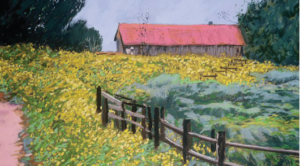
Frenchy’s Field Park, Spring in Santa Fe, New Mexico (oil) by Ralph C. Williams Jr.
Ralph C. Williams Jr. (Feb. 17, 1928–Feb. 2, 2020) was destined to become an artist. He started painting when he was 8 years old and never stopped. His journey, however, included a substantial career as a rheumatologist.
After completing his training in internal medicine at Massachusetts General Hospital, Boston, he joined the Rockefeller Institute in New York to work in the lab of Henry G. Kunkel, where he helped define the role of rheumatoid factor and complement in the pathogenesis of rheumatic diseases. He was one of the first to describe the concept of the idiotype, which is foundational to our understanding of adaptive immunity.
His peripatetic career took him to the University of Minnesota, where he founded its rheumatology division, to the University of New Mexico (UNM) School of Medicine, Albuquerque, where he served as chair of medicine for 20 years, and then to Florida Medical Center, Gainesville, where he led the rheumatology division for a decade. Thereafter, he returned to New Mexico, where he continued to work part time as an emeritus professor of rheumatology at the University of New Mexico.
He also worked two days each week with Fredrica Smith, MD, one of his previous residents at UNM, in Los Alamos in her private practice of rheumatology. In 2008, Dr. Williams retired from both UNM and Dr. Smith’s office, but continued to work several days a week in Santa Fe.
Dr. Williams was an ACR Presidential Gold Medal winner (2004) and an ACR Master.
“My dad was really good at collaborating with doctors/scientists around the world,” says Dr. Williams’ son, Mike. “He published many articles and wrote quite a few books. He truly loved what he did.”
“Dr. Williams was a superb researcher, teacher, clinician and master diagnostician, and mentor to many during his career,” says Dr. Smith. “He taught all of us to care for the patient as a person, to search for answers whether at the bedside or in the lab, and to be willing to ask for advice from others. It was a pleasure to know him first as a resident and many years later as a colleague in practice and to know both him and his wife, Mary, as friends.”
During his retirement, Dr. Williams found more time to devote to his painting. His artwork featured broad panoramas as seen through a post-impressionistic lens. His paintings captured the essence of the natural beauty that surrounded him and often featured scenes from his adopted home state of New Mexico.
According to Mike, Dr. Williams painted in watercolor, oil, acrylic and pastel. On Saturdays, he would crank up his favorite music—Peter, Paul and Mary, Joan Baez, various other folk musicians, lots of Spanish guitar with singing—and he would sing and paint along with the music. His focus was landscapes no matter where he lived.
Dr. Williams passed away on Feb. 2, 2020. In honor of his legacy, his family has graciously provided us with permission to use his works to illustrate this issue of The Rheumatologist. We think it is particularly fitting to use his art to illustrate an issue dedicated to education and educators. We are pleased to have this opportunity to celebrate Dr. Williams’ achievements and to share this side of his life with a broader audience. (See more of Dr. Williams’ paintings.)

